
June 2009
Volume 13, Number 1
| Contents | | | TESL-EJ Top |
 |
June 2009
|
||
|
| Title | EnglishClub.com |
| Author | Various |
| Contact Information | http://www.englishclub.com |
| Type of product | English learning Web site |
| Platform | Web |
| Minimum hardware requirement | Internet connection, browser |
| Supplementary software | None needed |
| Price | Free |
There are many ways to review language learning software. Currently, one of the most important ideas in literacy and language education is "new literacies." Lankshear and Knobel (2007) define new literacies as "socially recognized ways of generating, communicating and negotiating meaningful content through the medium of encoded texts within contexts of participation in Discourses" (p. 2). According to them, new literacies enable learners to be multi-literate in different discourses, each with different literacies. Thus, multi-literate language learners can use socially and culturally appropriate language within a broader range of discourse contexts (Cummins et al., 2007; Lankshear & Knobel, 2006). With school-based literacy only, learners can not have opportunities to practice other literacies in relation to their social relevance.
A key scheme of the new literacy idea is two different mindsets—Mindset 1 and Mindset 2 (Table 1, Lankshear & Knobel, 2006, p. 38).
Table 1. Mindset 1 versus Mindset 2
| Mindset 1 | Mindset 2 |
|---|---|
| The world is much the same as before, only now it is more technologized, or technologized in more sophisticated ways | The world is very different from before and largely as a result of the emergence and uptake of digital electronic inter-networked technologies: |
|
|
|
|
|
|
|
|
|
|
|
|
|
|
It is important to make the distinction between these two mindsets to crystallize the concept of new literacies as "social practices of meaning making" (Lankshear, 2007, p. 1), which is different from conventional literacies based on Mindset 1. From the standpoint of Mindset 2, technologies are viewed as tools to provide learning environments for learners to use the target language in various social discourse contexts in active collaboration with other learners or native English speakers. Thus, the main difference between Mindset 1 and Mindset 2 is that the latter draws on producing collective wisdom whereas the former, on consuming established knowledge. Also, Mindset 1 views technology as "tools for producing" while mindset 2 as "tools for mediating and relating." For example, Mindset 1 can be associated with Web 1.0 (e.g., Britannica Online, http://www.britannica.com/) while Mindset 2 can be associated with Web 2.0 (e.g., Wikipedia.org, blogs) (O'Reilly, 2005). Lankshear and Knobel (2007) note that having the newest technologies alone does not assure good online language learning content for new literacies. Similarly, Cummins et al. (2007) state that in order for learners to become multi-literate, they should not only be given opportunities to be cognitively engaged in instructional activities at school but they should also be given opportunities to be engaged in active collaboration within a community of learners. Therefore, it is crucial to consider these two different mindsets when designing or evaluating language learning software. In this review, I will use the scheme of Mindsets to evaluate EnglishClub.com.
EnglishClub.com is a Web site that helps English learners and teachers by providing useful resources such as Web-based lessons, quizzes, games, forum, chat, and blogs. This Web site consists of five sections: 1) Learn English, 2) Teach English, 3) ESL Resources, 4) ESL World, and 5) My EnglishClub, as shown in Figure 1
.
Figure 1. Five sections of EnglishClub.com
Each section provides several sub-sections with rich learning and teaching activities and resources. For example, Figure 2 shows the sub-sections of the Learning English section.
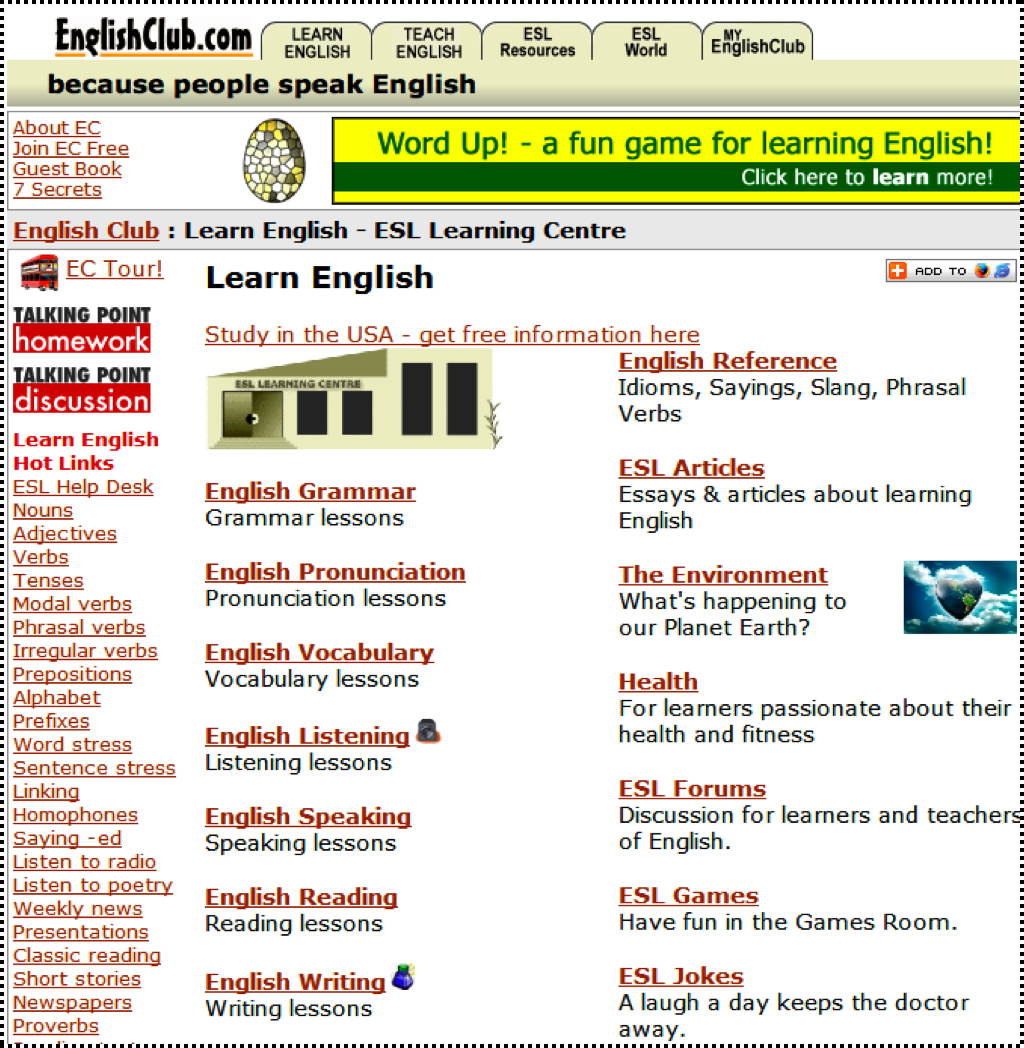
Figure 2. Contents of Learning English section
What is interesting about this Web site is the fact that the contents are based on two different mindsets. Englishclub.com presents both Mindsets because it contains elements of Web 1.0 and 2.0. As an example of Mindset 1, the "English Grammar" section of EnglishClub.com provides explanations about specific grammar forms and quizzes, as shown in Figures 3 and 4.
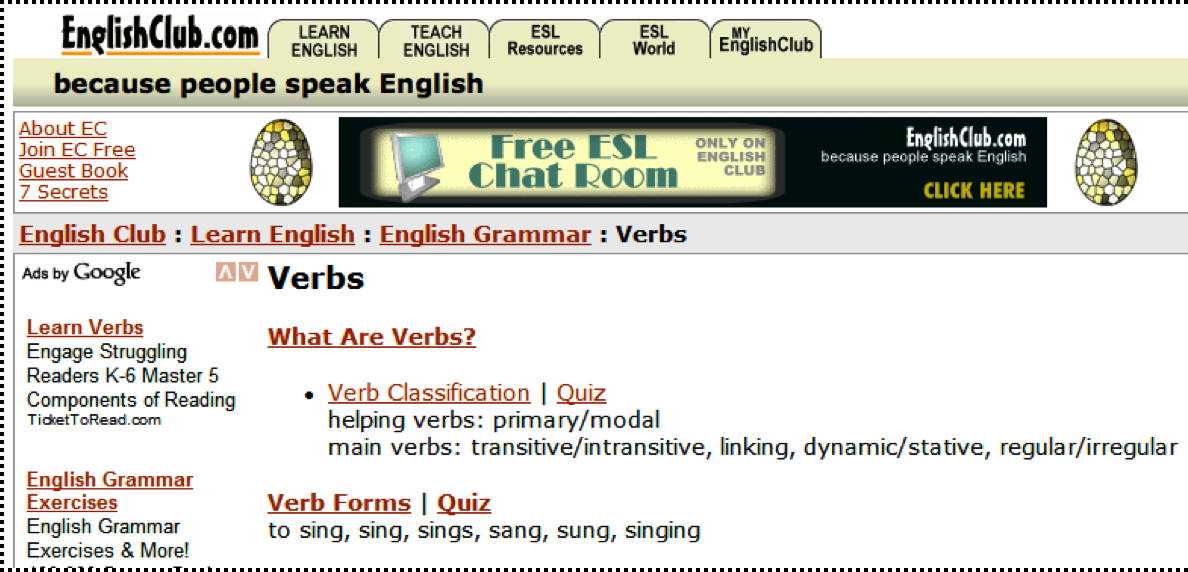
Figure 3. Sample English Grammar Explanations
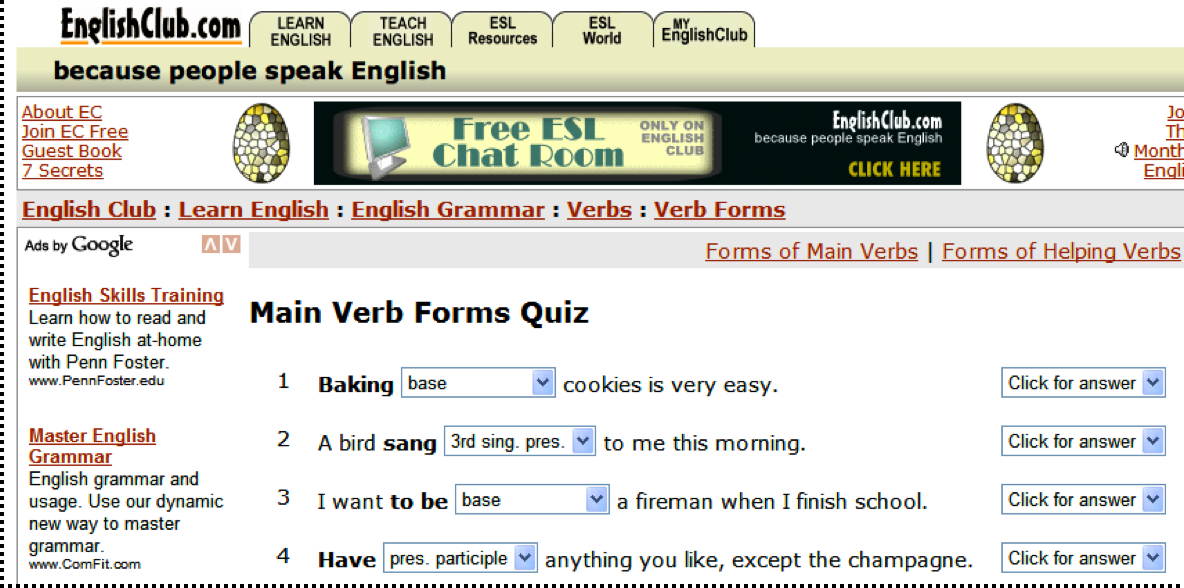
Figure 4. Sample English Grammar Quizzes
This page presents verb forms and quizzes about them. Learners can read the explanations on verbs and can take verb quizzes if they want. One advantage of this type of content is the fact that learners can be engaged in learning grammar at their own pace in a less-stressful environment, which Egbert at al. (2007) suggested as one of the requisite conditions for optimal language learning environments. However, the content of this page involves simply moving the contents of physical textbooks to a Web page. A problem with this is that if the goal is simply delivering knowledge, the use of technology is only an alternative to using physical textbooks and teachers' lessons since knowledge transmission can be done through classroom-based instruction. Also, these contents are static, readymade artifacts which the developers have produced for consumption. Therefore, learners and teachers are not expected to contribute their expertise or wisdom to the production of new knowledge in the "English Grammar" section.
On the other hand, the "My EnglishClub" section appears to draw on Mindset 2, which provides learners and teachers with extensive opportunities to be knowledge producers. This is shown in the following example on the My Video page (Figure 5) where users can add photos or videos to the page from YouTube, from Google, or directly from their phone by sending them to an e-mail address.
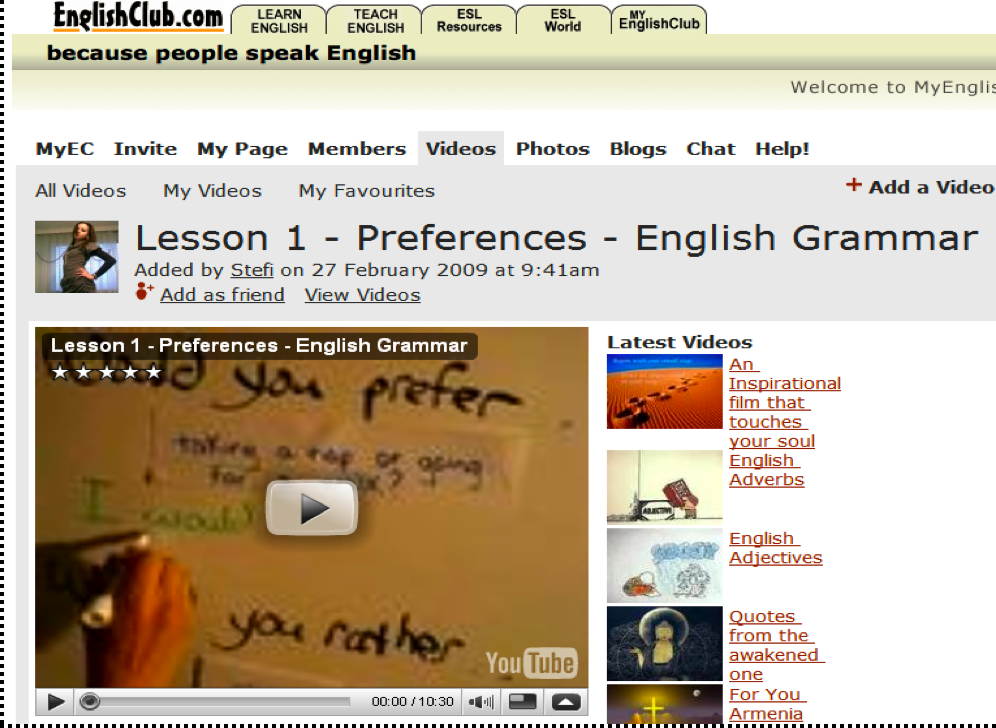
Figure 5. A Sample My Video Page
This example shows how learners can benefit from Web 2.0 through collective intelligence and through sharing learning experience. A female English learner from Bulgaria added excellent lesson video clips from YouTube, produced by a teacher who is a native speaker of English, to her personal page in order to learn English grammar in collaboration with other learners. On her page, there are a number of lesson video clips that teach English grammar, vocabulary, pop songs and so on. From her "profile information" part on "Members" page, she makes it clear that she wants to learn English grammar with other learners by stating as follows: —I'd like to practise it with someone, so if you want to practise together, just send me a message... And of course, I'll help you with English, if you want. I hope my videos, blog posts and playlist can help you improve your English. After the videos included in 'Common mistakes in English' and 'English vocabulary', I started to share new videos-this time the collection is 'English Grammar Lessons with JenniferESL'.— If you have a suggestion about a new topic, write a message.
Her intention in building up a learning community by sharing video clips and learning experience is shown in part, "I'd like to practice it with someone" and "I started to share new videos." Also, she invites other learners' participation by saying "if you want to practice together, just send me a message," "I'll help you with English," and "If you have a suggestions about a new topic, write a message." In response to her invitation, one learner wrote, "—I'm new here, I would like learn English with you." In this way, learners voluntarily join the learning community outside of the classroom, choose the content they want/need to learn, and share their learning experience. The example of sharing learning experience is more clearly shown in two learners' comments on another video clip, "Advise/Recommend/Suggest (Figure 6)."
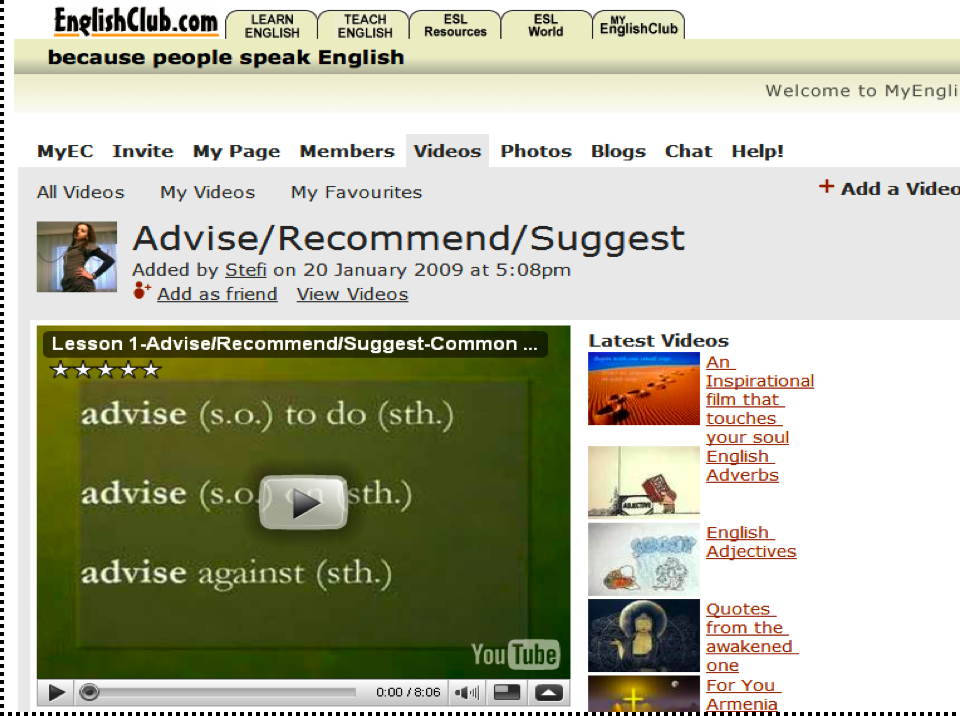
Figure 6. A Sample of My Video page
After watching this video clip, two learners wrote,
"tnx for the useful information... I knew them but it gave me opportunity for the decisive difference between the words in my mind:)"
"This information is very important, because it makes clear an understandable the use of the three words, thank you very much!"
Both comments suggest how this video clip helped them understand the concept more clearly. A mindset of "sharing" is one of important characteristics of Web 2.0. Learners review other learners' comments on each video clip to find a good one for their individual interests and needs. Sharing learning experience is beneficial for learners because this provides them with opportunities to reflect on their own learning and to evaluate it by writing comments on the video clip in the target language. In addition, they have to read critically to make a good choice of lesson video clips, relating the concepts to their own learning. The learners' cognitive engagement in critical literacy is one of the key elements for multiliteracies (Cummins et al., 2007). Furthermore, these types of activities can harness collective intelligence in the form of reader engagement and user comments by turning users into "experts" and "authorities" on lesson video clip data (e.g., Amazon.com database for books) (Lankshear & Knobel, 2006).
Another example of lesson of Mindset 2 demonstrates how users' role as knowledge producers can contribute to learner autonomy (Figure 7).
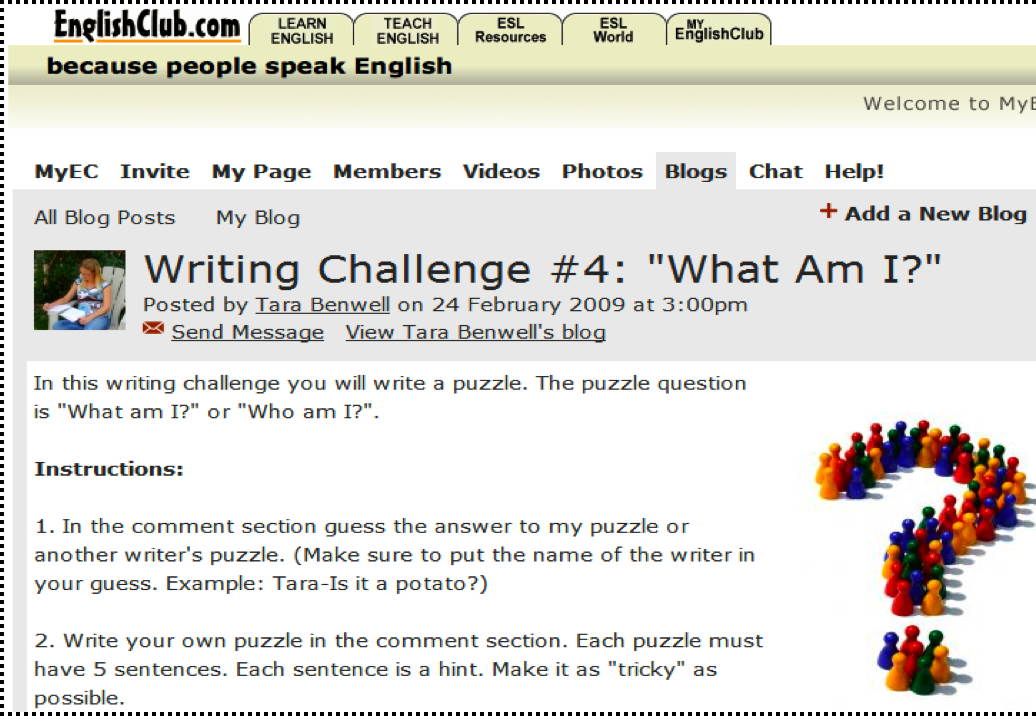
Figure 7. Sample Blog Page
This personal blog page is designed by a native-speaking English teacher to help English learners with writing. It shows how learners can be empowered through Web 2.0 applications, as O'Reilly (2005) states. In this example, an English teacher encourages learners to write their own puzzles. She gives directions about how to write a puzzle and provides a sample puzzle. Thus, learners produce their own puzzles with the teacher's corrections of their language use, which in turn invites other learners and the teacher to solve the puzzle in collaboration (see Figure 8).
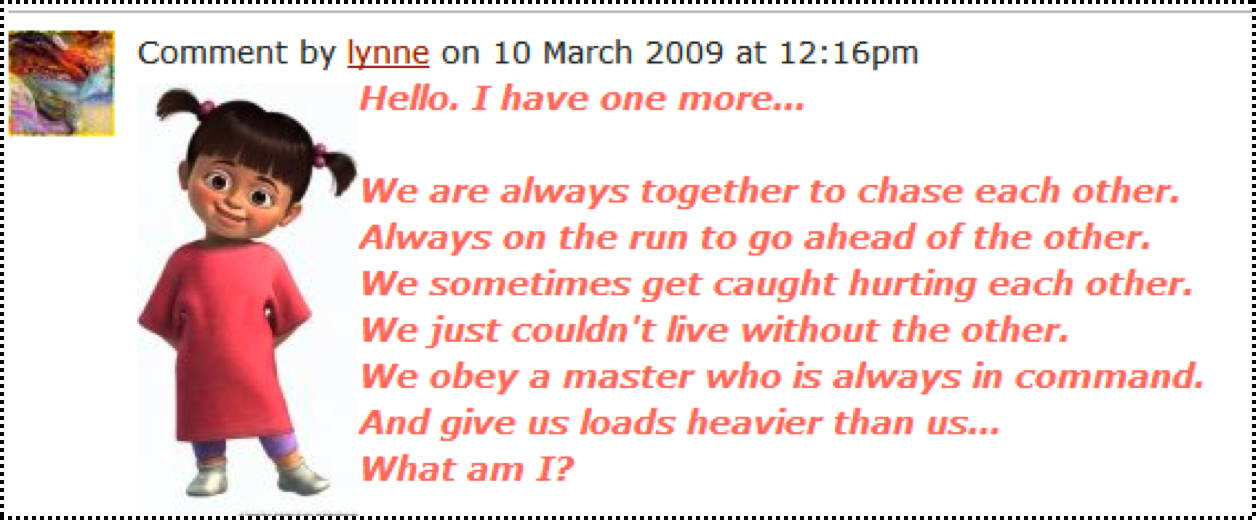
Figure 8. A Sample Puzzle Produced by a Learner
Figure 8 shows an example of a puzzle that a learner generated. This way, learners can be engaged in asynchronous interaction to help each other solve puzzles by reflecting, commenting, and questioning outside the classroom. They are not passive knowledge receivers but active knowledge producers. The learner empowerment, reflection, and interactive language use shown in this example are important characteristics of Web 2.0. These traits can positively affect learners because, according to Little (2000), these three (learner empowerment, reflectivity, and appropriate target language use) are crucial components in order for them to be autonomous language learners. Learner autonomy is important for foreign language learning since it enables learners to use the knowledge and skills learned in the classroom in the world beyond. The "Blogs" page provides environments where learners can practice learner autonomy so that they can internalize and use knowledge learned through classroom-based instruction appropriately in real-life situations.
To conclude, there are good reasons why teachers and learners should use EnglishClub.com to benefit their teaching and learning. First, they can benefit from both Web 1.0 and Web 2.0 learning contents depending on their needs and contexts. Although this review focused more on Web 2.0 contents, this does not mean that teachers and learners should entirely depend on Web 2.0 applications. As discussed at the beginning of the review, both teaching knowledge and engaging learners in active collaboration within a community of learners in authentic meaningful contexts are important in order to for them to acquire multiliteracies (Cummins et al., 2007). Thus, teachers can use Web 1.0 applications to provide instructional activities and Web 2.0 contents to leverage learners' collective intelligence, critical literacy, and learner autonomy. Second, teachers can selectively use the Web 1.0 or Web 2.0 contents depending on their students and their mindsets (Mindset 1 or 2). For example, English teachers who teach Mindset 1 learners (e.g., adults) can encourage their students to practice English through Web 1. 0 activities such as English Grammar Quizzes and English World, while those who teach Mindset 2.0 learners (e.g., children) can let them engage in Web 2.0 activities such as blogs and My Video. The Mindset 2 learners can enhance their learning of multiliteracies by using Web 2.0 contents.
Cummins, J., Brown, K., & Sayers, D. (2007). Literacy, technology, and diversity: Teaching for success in changing times. Boston: Allyn & Bacon/Pearson.
Egbert, J., Chao, C., Hanson-Smith, E. (2007). Computer-enhanced language learning environments: An overview. In J. Egbert and E. Hanson-Smith (Eds.), CALL environments: Research, practice, and critical Issues (pp. 1-13). Alexandria: TESOL.
Lankshear, C., & Knobel, M. (2006). New literacies: Everyday practices and classroom Learning (2nd ed.). New York: Open University Press.
Lankshear, C. (2007). The stuff of new literacies. Retrieved March 3, 2009, from http://www.geocities.com/c.lankshear/stuff.pdf
Little, D. (2000). We're all in it together: Exploring the interdependence of teacher and learner autonomy. Learning Learning, 8(2), Retrieved March 21, 2009, from http://coyote.miyazaki-mu.ac.jp/learnerdev/LLE/8.2/littleE.html
O'Reilly, T. (2005). What is Web 2.0?: Design patterns and business models for the next generation of software. Retrieved March 14, 2004, from http://www.oreillynet.com/pub/a/oreilly/tim/news/2005/09/30/what-is-Web-20.html
HyunGyung Lee is a PhD student in the Literacy and ESL Education program at Washington State University. Her major interest areas are CALL and EFL curriculum/material development. She worked as an EFL teacher and as an online EFL curriculum/materials developer in Korea.
|
© Copyright rests with authors. Please cite TESL-EJ appropriately.
Editor's Note: The HTML version contains no page numbers. Please use the PDF version of this article for citations. |